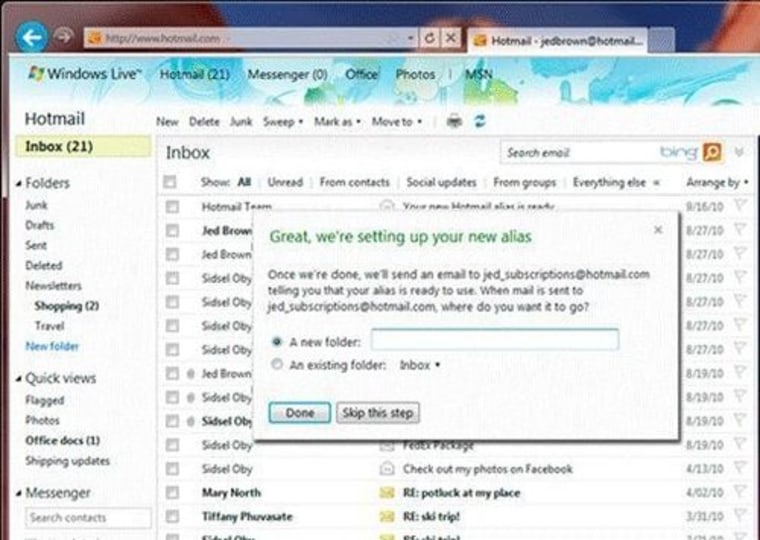The average person maintains three different e-mail addresses, Microsoft says: one for personal use, another for business and yet another for keeping "junk mail away from a primary e-mail address." To make it easier for you — and to make sure you stick with them — Microsoft is now letting users of its free Hotmail e-mail service create and manage multiple e-mail aliases from a single account.
"There are many good reasons that people want multiple e-mail addresses, but maintaining multiple accounts, with different user names and passwords that require you to check multiple inboxes, is inefficient," said Dharmesh Mehta, Windows Live Product Management director, on a Microsoft blog. The ability to use multiple e-mail aliases "helps you save time by making it easier to manage your current and future e-mail addresses in one place."
(Msnbc.com is a joint venture of Microsoft and NBC Universal.)
Hotmail and other e-mail services like Google and Yahoo "already allow you to just add a plus sign ('+') and a descriptive word to the first part of your e-mail address," Mehta said. "For instance, if your e-mail address was doctor-smith@live.com and you wanted to create an alias for online shopping, you could use doctor-smith+shopping@live.com. E-mail sent to this alias will still be delivered to your inbox or to a particular folder. This can help with managing different types of incoming e-mail."
But, he says, "with the plus addresses that many services offer, it’s still very easy to determine your actual e-mail address and there are times when you simply don’t want to give out any part of your real e-mail address— that’s where our new alias feature helps you out. E-mail aliases let you create completely different e-mail addresses that you can use to receive e-mail into your primary account without anyone knowing what your primary e-mail address is."
Hotmail users can add up to five aliases a year to their Hotmail account, and "up to 15 aliases in total," Mehta said. (Yahoo, for example, now allows up to six aliases, the site says).
The impetus to keep Hotmail's estimated 40-million plus customers happy is strong. Gmail, Yahoo and Hotmail are the leading free Web-based e-mail services, but fewer of us are turning to such sites as we spend more time reaching out to people via mobile e-mail, or using websites like Facebook and Twitter to communicate.
A recent comScore report noted that as of last November, "The number of visitors to Web-based e-mail sites declined 6 percent compared to the previous year, while e-mail engagement declined at an even greater rate.
"During the same time period, the number of users accessing e-mail via their mobile devices grew by 36 percent as an increasingly complex digital environment influenced consumers’ communication habits."
Still, no one's saying e-mail is over — yet: "Despite such declines, however, it should be noted that e-mail remains one of the most popular activities on the Web, reaching more than 70 percent of the U.S online population each month," comScore said.
